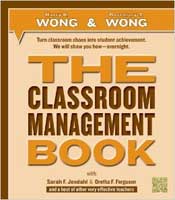|
 |

Special to the Gazette
December 2014/January 2015
Making Deals Is Ineffective Teachers are loving people who come into the profession to make a difference in the lives of children. Their intentions are good, but when misbehavior occurs, some teachers will, out of sheer frustration, resort to making deals with the students just to survive.
You may find some of these silly and funny, but they are all actual events that have been observed in the classroom.
Making deals with students is not effective teaching. It teaches students that when they grow up, everything will be negotiable, and they will take no responsibility for their actions or work. If bargaining does not work—and it does not—teacher behavior may escalate from frustration to threats, coercion, punishment, and humiliation, because survival is the last resort. Some teachers and principals have resorted to these acts to “get students to behave.”
None of these have to do with coercion or punishment; these acts are all about humiliation. It’s the teacher and the profession that suffers when humiliation is used. And as for threatening students, that may the most dangerous thing to do as the student may well threaten you in return. There is a solution to refraining from making deals and coercing students and acting in a less than professional manner. It Is Much Easier to Teach Procedures Oretha Ferguson of Fort Smith, Arkansas, says, “These deals just amaze me. It’s much easier to just teach, rehearse, and reinforce procedures than to play these “'games.'” The solution—teachers like Oretha know how to manage their classrooms with procedures. Click here to see how Oretha can easily get her students to do what she wants them to do—with poise, respect, love. Before you shake your head in dismay and make fun of the examples of deals and coercion we’ve shared, we emphatically believe that none of the above would have happened had the individuals involved been taught how to manage a classroom. No teacher comes into the profession to humiliate people, but if they have received absolutely no training in what to proactively do with misbehavior, they may resort to tactics from making deals to threatening students. When teachers do not know what to do, they may REACT to a problem that will intensify the problem even more. Whereas, when teachers know what to do, they are PROACTIVE. They put into action a plan or procedures to solve the problem. They are knowledgeable in classroom management skills in how to get students to do what you want them to do, and do it responsibly even if you should not be in the classroom. The Solution When you can get students to do what you want them to do, then they will not do what you do not want them to do. How do you get students to do what you want them to do?
Learning how to create a classroom management plan begins at the university. We’ve written several articles on this topic.
Upon employment in a school district, there should be a comprehensive induction program that teaches teachers how to create a classroom management plan. We’ve written several articles on this topic. Your school should have an instructional leader in a principal who teaches teachers how to plan and implement a classroom management plan. We’ve written several articles on this topic.
At the classroom level, Sarah Jondahl of Brentwood, California, says, “I do not have any major behavior problems with my students. Most important, I always get high academic results from my students.” Sarah’s classroom management plan can be seen in THE Classroom Management Book, pages 287–290. Procedures Are Most Effective Negotiating deals strikes fear in most people. Meeting eye to eye to carve the political future of a nation, the purchase of a new car, or settle an argument with a loved one, all involve skill and practice for successful outcomes. The teaching of procedures to students is a skill and gets easier and easier the more the skill is practiced. Your skill level is increased with each successful outcome and your confidence grows. There are no shortcuts to teaching a procedure. Everyone can teach procedures. It is a process with defined steps that ensure success. Teach. Rehearse. Reinforce. Using procedures is a proactive way to avoid having to make deals with students. Procedures allow everyone to know upfront what the expectation is and how the outcome will allow for everyone’s success in the classroom. Procedures create a win-win outcome. Everyone benefits. The classroom plan that you’ve created is in place and the students are achieving success. Is this not the goal of everyone in the profession? You don’t need to broker a deal to make this happen in your classroom. You need to have a vision of how you see your classroom succeeding, devise a plan to make that happen, and then teach that plan to your students. Be a confident role model for your students—someone who is professional in demeanor, composure, and care. Your days will be free of deals and filled with the fulfillment of a job well done.
|
|||||||||||||||
|








